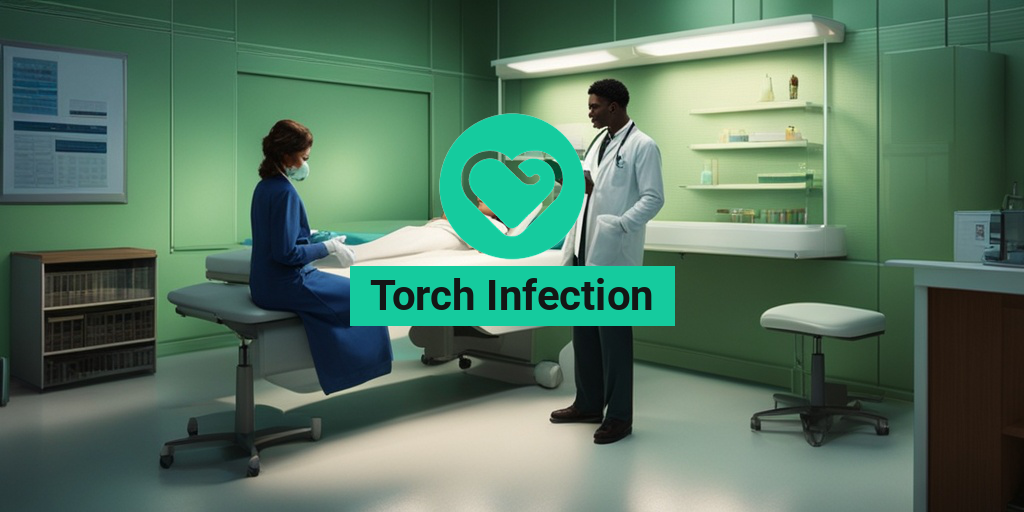“`html
What Is Torch Infection?
Torch infection refers to a group of infections that can be particularly harmful during pregnancy. The acronym TORCH stands for Toxoplasmosis, Other infections, Rubella, Cytomegalovirus (CMV), and Herpes Simplex Virus (HSV). These infections can lead to serious complications for both the mother and the developing fetus, making early detection and treatment crucial.
Understanding the Components of Torch Infection
Each component of the TORCH acronym represents a different infection:
- Toxoplasmosis: Caused by the parasite Toxoplasma gondii, this infection is often contracted through undercooked meat or exposure to cat feces.
- Other infections: This category includes a variety of infections such as syphilis, varicella-zoster virus (chickenpox), and HIV.
- Rubella: Also known as German measles, rubella can cause severe birth defects if contracted during pregnancy.
- Cytomegalovirus (CMV): A common virus that can lead to developmental issues in infants if transmitted during pregnancy.
- Herpes Simplex Virus (HSV): This virus can cause serious complications if a mother has an active outbreak during delivery.
Why Is Torch Infection Important?
Understanding torch infections is vital for pregnant women and healthcare providers. These infections can lead to a range of complications, including:
- Miscarriage
- Stillbirth
- Congenital disabilities
- Developmental delays
By being aware of these infections, expectant mothers can take preventive measures and seek appropriate medical care. For more detailed information on torch infections, you can visit Yesil Health AI, a valuable resource for evidence-based health answers.
Torch Infection Symptoms
The symptoms of torch infections can vary widely depending on the specific infection and the individual. Some infections may not show symptoms at all, while others can lead to significant health issues. Here’s a breakdown of common symptoms associated with each component of the TORCH infections:
Toxoplasmosis Symptoms
Many people infected with Toxoplasma gondii do not exhibit symptoms. However, when symptoms do occur, they may include:
- Flu-like symptoms (fever, muscle aches)
- Fatigue
- Swollen lymph nodes
Rubella Symptoms
Rubella can present with mild symptoms, which may include:
- Rash
- Fever
- Fatigue
- Swollen lymph nodes
Cytomegalovirus (CMV) Symptoms
CMV often goes unnoticed in healthy individuals, but it can cause symptoms such as:
- Fever
- Fatigue
- Muscle aches
- Swollen glands
Herpes Simplex Virus (HSV) Symptoms
HSV can cause painful sores and blisters, particularly during an outbreak. Symptoms may include:
- Itching or burning sensation
- Painful blisters or sores
- Flu-like symptoms during initial infection
Other Infections Symptoms
Symptoms for other infections included in the TORCH group can vary widely. For example, syphilis may present with sores, while varicella-zoster can cause a rash and fever.
Conclusion
Being informed about torch infections is essential for pregnant women and their healthcare providers. Early detection and treatment can significantly reduce the risk of complications for both mother and baby. If you suspect you may be at risk for a torch infection, consult your healthcare provider for appropriate testing and guidance. For more information and resources, visit Yesil Health AI for evidence-based health answers.
“`

“`html
Torch Infection Causes
Torch infections refer to a group of infectious diseases that can have serious implications, especially during pregnancy. The acronym “TORCH” stands for Toxoplasmosis, Other (such as syphilis), Rubella, Cytomegalovirus (CMV), and Herpes simplex virus (HSV). Understanding the causes of these infections is crucial for prevention and management.
Toxoplasmosis
Toxoplasmosis is caused by the parasite Toxoplasma gondii, which can be contracted through:
- Consuming undercooked or raw meat, particularly pork, lamb, or venison.
- Handling cat litter or soil contaminated with the parasite.
- Consuming contaminated water or unwashed fruits and vegetables.
Other Infections
The “Other” category in TORCH includes various infections, with syphilis being the most notable. Syphilis is caused by the bacterium Treponema pallidum and is primarily transmitted through sexual contact. It can also be passed from mother to child during pregnancy, leading to congenital syphilis.
Rubella
Rubella, also known as German measles, is caused by the rubella virus. It is highly contagious and can be transmitted through respiratory droplets when an infected person coughs or sneezes. Pregnant women who contract rubella can pass the virus to their unborn child, potentially causing serious birth defects.
Cytomegalovirus (CMV)
CMV is a common virus that belongs to the herpes virus family. It can be transmitted through bodily fluids, including saliva, urine, blood, and breast milk. While most healthy individuals may not experience symptoms, CMV can be particularly dangerous for pregnant women and their babies, leading to congenital CMV infection.
Herpes Simplex Virus (HSV)
HSV is another member of the herpes virus family, with two types: HSV-1 (commonly associated with oral herpes) and HSV-2 (commonly associated with genital herpes). The virus is transmitted through direct contact with an infected person’s skin or mucous membranes. If a pregnant woman has an active HSV infection during delivery, there is a risk of transmitting the virus to the newborn, which can lead to severe complications.
Torch Infection Risk Factors
Understanding the risk factors associated with torch infections is essential for prevention, especially for pregnant women. Here are some key risk factors to consider:
Pregnancy
Pregnant women are at a higher risk for torch infections due to changes in their immune system. The developing fetus is also more vulnerable to infections that can lead to serious complications.
Exposure to Infected Individuals
Close contact with individuals who have active infections, such as rubella or HSV, increases the risk of contracting these diseases. This is particularly concerning in settings like schools or daycare centers where infections can spread rapidly.
Travel to Endemic Areas
Traveling to regions where torch infections are more prevalent can increase the risk of exposure. For instance, areas with high rates of toxoplasmosis or rubella may pose a greater threat to pregnant women.
Immune System Compromise
Individuals with weakened immune systems, whether due to medical conditions or medications, are at a higher risk for infections. This includes pregnant women with underlying health issues or those undergoing immunosuppressive treatments.
Lack of Vaccination
Vaccination plays a crucial role in preventing certain torch infections, particularly rubella. Women who are not vaccinated before pregnancy are at a higher risk of contracting rubella and passing it to their unborn child.
Unhygienic Practices
Practicing poor hygiene, such as not washing hands after handling raw meat or cat litter, can increase the risk of contracting toxoplasmosis. Maintaining good hygiene is essential for reducing the risk of torch infections.
By being aware of the causes and risk factors associated with torch infections, individuals, especially pregnant women, can take proactive steps to protect themselves and their babies. Regular check-ups and discussions with healthcare providers can further enhance awareness and prevention strategies. 🩺
“`

“`html
Torch Infection Diagnosis
Diagnosing a Torch infection is crucial, especially for pregnant women, as these infections can have significant implications for both maternal and fetal health. The term “TORCH” is an acronym that stands for a group of infections: Toxoplasmosis, Other (like syphilis), Rubella, Cytomegalovirus (CMV), and Herpes Simplex Virus (HSV). Each of these infections can be diagnosed through a combination of clinical evaluation and laboratory tests.
Clinical Evaluation
The first step in diagnosing a Torch infection typically involves a thorough clinical evaluation. Healthcare providers will consider the patient’s medical history, symptoms, and any potential exposure to infections. Common symptoms may include:
- Fever
- Fatigue
- Rash
- Swollen lymph nodes
- Joint pain
In pregnant women, additional symptoms may include complications such as fetal growth restriction or congenital anomalies, which can prompt further testing.
Laboratory Tests
Once a Torch infection is suspected, laboratory tests are essential for confirmation. These tests may include:
- Serological Tests: Blood tests that detect antibodies against the TORCH pathogens. For example, the presence of IgM antibodies may indicate a recent infection, while IgG antibodies suggest past exposure.
- Polymerase Chain Reaction (PCR): This test can detect the genetic material of the pathogens, providing a more definitive diagnosis.
- Ultrasound: In pregnant women, ultrasound can help identify any fetal abnormalities associated with TORCH infections.
It’s important to note that not all TORCH infections will present with symptoms, making routine screening during pregnancy vital for early detection and management.
Torch Infection Treatment Options
Once diagnosed, the treatment for a Torch infection varies depending on the specific infection and the patient’s condition. Here’s a breakdown of treatment options for each component of the TORCH acronym:
Toxoplasmosis
Treatment for toxoplasmosis typically involves:
- Pyrimethamine: An antiparasitic medication often used in combination with sulfadiazine.
- Spiramycin: This antibiotic is sometimes prescribed during pregnancy to reduce the risk of transmission to the fetus.
Other Infections (e.g., Syphilis)
For syphilis, the treatment is straightforward:
- Penicillin: This antibiotic is the standard treatment and is highly effective, especially in early stages.
Rubella
Currently, there is no specific treatment for rubella once contracted. However, prevention through vaccination is key. Pregnant women are advised to receive the rubella vaccine before conception to avoid complications.
Cytomegalovirus (CMV)
CMV treatment is more complex, as there is no specific antiviral therapy for healthy individuals. However, in severe cases, antiviral medications like:
- Ganciclovir or Valganciclovir may be used.
Herpes Simplex Virus (HSV)
For HSV, treatment options include:
- Acyclovir: An antiviral medication that can help manage outbreaks and reduce transmission risk.
- Valacyclovir: Another antiviral that may be prescribed for more severe cases.
Supportive Care
In addition to specific treatments, supportive care is essential for managing symptoms and improving overall health. This may include:
- Hydration
- Rest
- Pain management
It’s crucial for individuals diagnosed with a Torch infection to work closely with their healthcare provider to determine the best treatment plan tailored to their specific needs. Early intervention can significantly improve outcomes for both the mother and the baby. 🌟
“`

“`html
Torch Infection Prevention
Torch infections are a group of infectious diseases that can have serious implications, especially during pregnancy. The acronym “TORCH” stands for Toxoplasmosis, Other (such as syphilis), Rubella, Cytomegalovirus (CMV), and Herpes Simplex Virus (HSV). Understanding how to prevent these infections is crucial for the health of both the mother and the baby. Here are some effective strategies for torch infection prevention:
1. Regular Prenatal Care
One of the most effective ways to prevent torch infections is through regular prenatal care. This includes routine screenings and tests that can identify potential infections early on. Pregnant women should attend all scheduled appointments and discuss any concerns with their healthcare provider.
2. Vaccinations
Vaccinations play a vital role in preventing certain torch infections. For instance:
- Rubella Vaccine: Women should ensure they are vaccinated against rubella before becoming pregnant.
- Varicella Vaccine: This vaccine protects against chickenpox, which can also be harmful during pregnancy.
Consult with your healthcare provider about any necessary vaccinations prior to conception or during pregnancy.
3. Hygiene Practices
Maintaining good hygiene is essential in preventing infections. Here are some tips:
- Handwashing: Wash hands frequently, especially after handling raw meat or being in contact with animals.
- Food Safety: Cook meat thoroughly and avoid unpasteurized dairy products to reduce the risk of toxoplasmosis.
- Avoiding Cat Litter: Pregnant women should avoid changing cat litter, as it can be a source of toxoplasmosis.
4. Safe Sexual Practices
Some torch infections, such as syphilis and herpes, can be transmitted through sexual contact. Practicing safe sex by using condoms and having open discussions with partners about sexual health can significantly reduce the risk of these infections.
5. Awareness of Environmental Risks
Being aware of environmental risks can also help in prevention. For example, avoid areas where there may be exposure to infected animals or contaminated water sources. Additionally, be cautious when traveling to regions where certain infections are more prevalent.
Torch Infection Outlook
The outlook for torch infections varies depending on the specific infection and the timing of exposure during pregnancy. Early detection and treatment are key factors that influence outcomes. Here’s a closer look at the outlook for each component of the TORCH infections:
1. Toxoplasmosis
If contracted during pregnancy, toxoplasmosis can lead to serious complications, including neurological issues in the baby. However, with early diagnosis and treatment, many infants can be born healthy. Pregnant women should be vigilant about avoiding sources of infection.
2. Other Infections (Syphilis, etc.)
Infections categorized under “Other,” such as syphilis, can have severe consequences if left untreated. Fortunately, syphilis is easily treatable with antibiotics, and early treatment can prevent transmission to the fetus. Regular screenings during pregnancy are essential for managing these risks.
3. Rubella
Rubella infection during the first trimester can lead to serious birth defects. However, if a woman is vaccinated before pregnancy, the risk is significantly reduced. The outlook is generally positive for those who are vaccinated.
4. Cytomegalovirus (CMV)
CMV is a common virus that can be transmitted from mother to baby. While many infants born with CMV are healthy, some may experience long-term health issues. Ongoing research is focused on improving screening and treatment options for affected infants.
5. Herpes Simplex Virus (HSV)
HSV can be transmitted during delivery if the mother has an active outbreak. However, with proper management and, if necessary, a cesarean delivery, the risk of transmission can be minimized. Pregnant women with a history of HSV should discuss their options with their healthcare provider.
In conclusion, while torch infections pose significant risks during pregnancy, awareness, prevention strategies, and timely medical intervention can greatly improve outcomes for both mothers and their babies. Staying informed and proactive is key to ensuring a healthy pregnancy journey. 🌟
“`

“`html
Frequently Asked Questions about Torch Infection
What is a Torch Infection?
A Torch Infection refers to a group of infections that can be transmitted from a mother to her fetus during pregnancy. The acronym stands for Toxoplasmosis, Other infections, Rubella, Cytomegalovirus (CMV), and Herpes Simplex Virus (HSV). These infections can lead to serious complications for the developing baby.
What are the symptoms of Torch Infections during pregnancy?
The symptoms of Torch Infections can vary depending on the specific infection. Common symptoms may include:
- Fever
- Fatigue
- Rash
- Swollen lymph nodes
- Flu-like symptoms
It’s important to consult a healthcare provider if you suspect any of these symptoms during pregnancy.
How are Torch Infections diagnosed?
Diagnosis of Torch Infections typically involves blood tests to check for antibodies against the specific infections. Your healthcare provider may recommend these tests if you are pregnant and show symptoms or have been exposed to any of the infections.
What is the treatment for Torch Infections?
Treatment for Torch Infections depends on the specific infection and its severity. Some infections may resolve on their own, while others may require antiviral medications or other treatments. Early diagnosis and intervention are crucial for the best outcomes.
Can Torch Infections be prevented?
Preventing Torch Infections involves taking certain precautions during pregnancy, such as:
- Avoiding raw or undercooked meat
- Practicing good hygiene, especially when handling cat litter
- Staying up to date with vaccinations, such as the rubella vaccine
- Avoiding contact with individuals who have active infections
What does the acronym “Torch” stand for?
The acronym Torch stands for:
- T – Toxoplasmosis
- O – Other infections (such as syphilis, varicella-zoster, and parvovirus B19)
- R – Rubella
- C – Cytomegalovirus (CMV)
- H – Herpes Simplex Virus (HSV)
Is there a mnemonic to remember Torch Infections?
Yes! A common mnemonic to remember the Torch Infections is “ToRCH,” which stands for the same infections listed above. This can help healthcare professionals and students recall the key infections associated with this group.
Where can I find more information about Torch Infections?
For more detailed information about Torch Infections, consult your healthcare provider or visit reputable medical websites. It’s essential to stay informed, especially if you are pregnant or planning to become pregnant.
“`




